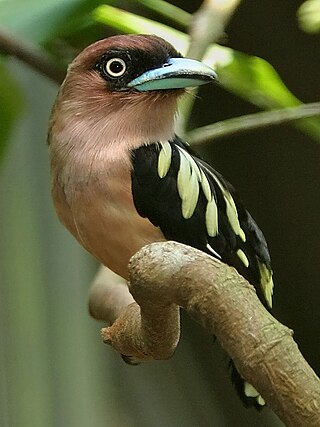
A passerine is any bird of the order Passeriformes, which includes more than half of all bird species. Sometimes known as perching birds, passerines generally have an anisodactyl arrangement of their toes, which facilitates perching.

The buntings are a group of Old World passerine birds forming the genus Emberiza, the only genus in the family Emberizidae. The family contains 45 species. They are seed-eating birds with stubby, conical bills.

The Accipitriformes are an order of birds that includes most of the diurnal birds of prey, including hawks, eagles, vultures, and kites, but not falcons.

The bushtits or long-tailed tits are small passerine birds from the family Aegithalidae, containing 13 species in three genera, all but one of which (Psaltriparus) are found in Eurasia. Bushtits are active birds with long tails compared to their size, moving almost constantly while they forage for insects in shrubs and trees. During non-breeding season, birds live in flocks of up to 50 individuals. Several bushtit species display cooperative breeding behavior, also called helpers at the nest.

Pittas are a family, Pittidae, of passerine birds found in Asia, Australasia and Africa. There are 44 species of pittas, all similar in general appearance and habits. The pittas are Old World suboscines, and their closest relatives among other birds are in the genera Smithornis and Calyptomena. Initially placed in a single genus, as of 2009 they have been split into three genera: Pitta, Erythropitta and Hydrornis. Pittas are medium-sized by passerine standards, at 15 to 25 cm (5.9–9.8 in) in length, and stocky, with strong, longish legs and long feet. They have very short tails and stout, slightly decurved bills. Many have brightly coloured plumage.

The gnatcatchers are a family of small passerine birds called Polioptilidae. The 21 species occur in North and South America. Most species of this mainly tropical and subtropical group are resident, but the blue-grey gnatcatcher of the United States and southern Canada migrates south in winter. They are close relatives of the wrens.

The Eurylaimidae are a family of suboscine passerine birds that occur from the eastern Himalayas to Indonesia and the Philippines. The family previously included the sapayoa from the Neotropics, the asities from Madagascar, and the Calyptomenidae from Africa and Asia, but these are now separated into distinct families.

The Tyranni (suboscines) are a suborder of passerine birds that includes more than 1,000 species, the large majority of which are South American. It is named after the type genus Tyrannus.

Estrildidae, or estrildid finches, is a family of small seed-eating passerine birds of the Old World tropics and Australasia. They comprise species commonly known as munias, mannikins, firefinches, parrotfinches and waxbills. Despite the word "finch" being included in the common names of some species, they are not closely related to birds with this name in other families, such as the Fringillidae, Emberizidae or Passerellidae.

The sapayoa or broad-billed sapayoa is a suboscine passerine bird found Colombia, Ecuador, and Panama.

The nine-primaried oscines is a group of bird families in the suborder Passeri (oscines) of the Passeriformes. The composition of the group has changed since the term was introduced but is now considered to consist of seven major families—Fringillidae, Emberizidae, Cardinalidae, Thraupidae, Passerellidae, Parulidae and Icteridae—plus some small families. When Fringillidae is omitted the remaining six families are referred to as the "New World" nine-primaried oscines.

Spindalis is a genus consisting of four non-migratory species of bird. It is the only genus in the family Spindalidae. The species are mostly endemic to the West Indies; exceptions include populations of western spindalises on Cozumel Island, off the Yucatán Peninsula's east coast, and in extreme southeastern Florida. The species were traditionally considered aberrant members of the tanager family Thraupidae. Taxonomic studies recover them as a sister group to the Puerto Rican tanager, and some group Spindalidae and Nesospingidae within the Phaenicophilidae.

Cettiidae is a newly validated family of small insectivorous songbirds ("warblers"), formerly placed in the Old World warbler "wastebin" assemblage. It contains the typical bush warblers (Cettia) and their relatives. As a common name, cettiid warblers is usually used.

Erythrocercus is a genus of birds containing three flycatchers that are found in Africa.

Eurylaimus is a genus of broadbills found in Southeast Asia.

Muscicapoidea is a superfamily belonging to the infraorder Passerides containing the Old World flycatchers, thrushes, starlings and their allies. The superfamily contains around 670 species.

Tyrannides is a clade of passerine birds that are endemic to the Americas. This group is divided into two clades that contain eleven families. The families listed here are those recognised by the International Ornithologists' Union (IOC).

Calyptomenidae is a family of passerine birds found in Africa, the Malay Peninsula and Borneo. There are six species in two genera.

Bombycilloidea is a superfamily of passerine birds that contains ten living species. They are found in North, Central America, most of the Palearctic, the Arabian Peninsula, the islands of Hispaniola and Sulawesi, and formerly the Hawaiian Islands.

Eupasserines are passerines in the clade Eupasseres. The clade contains all passerines except the New Zealand wrens (Acanthisitti), to which they are sister.




















